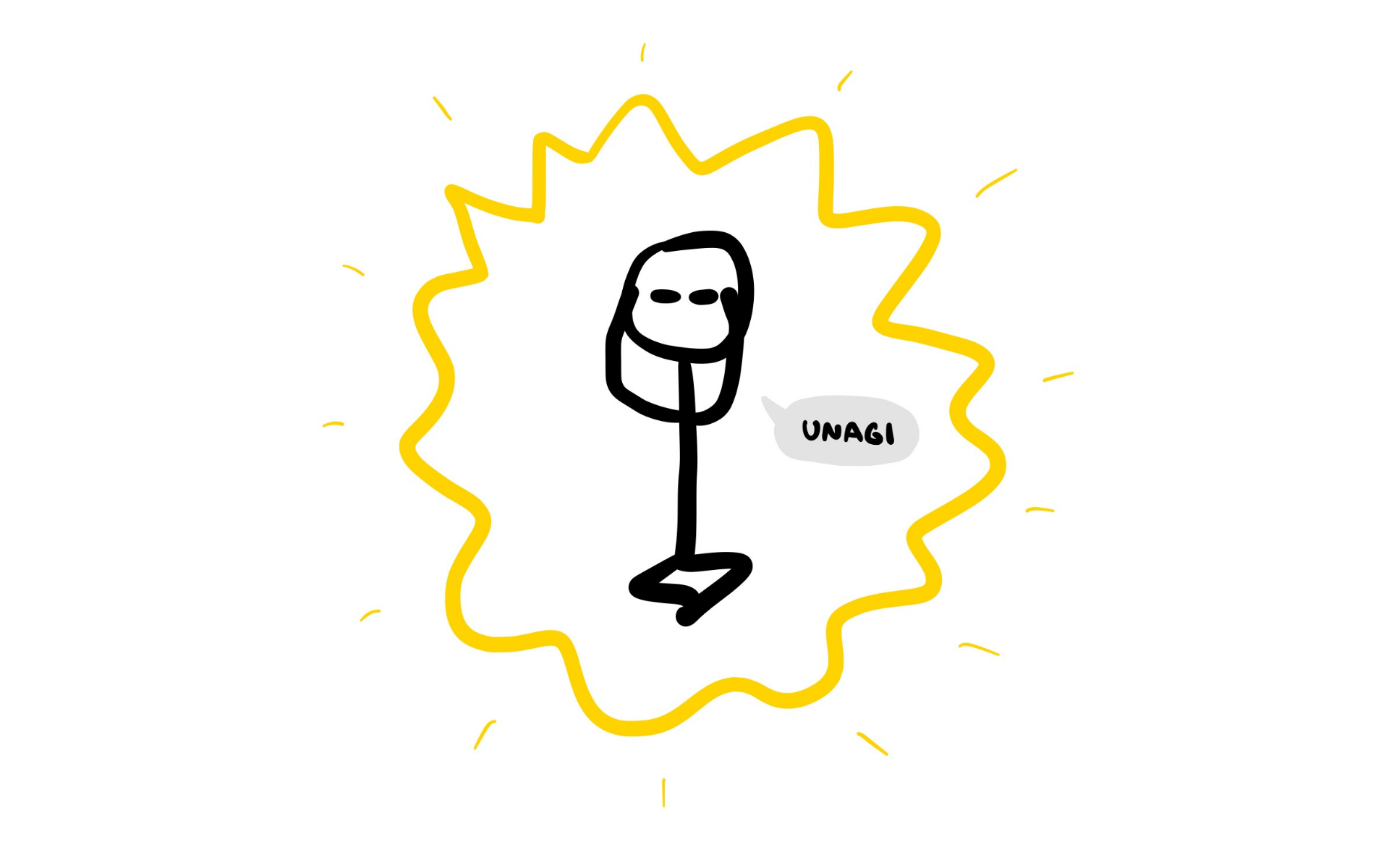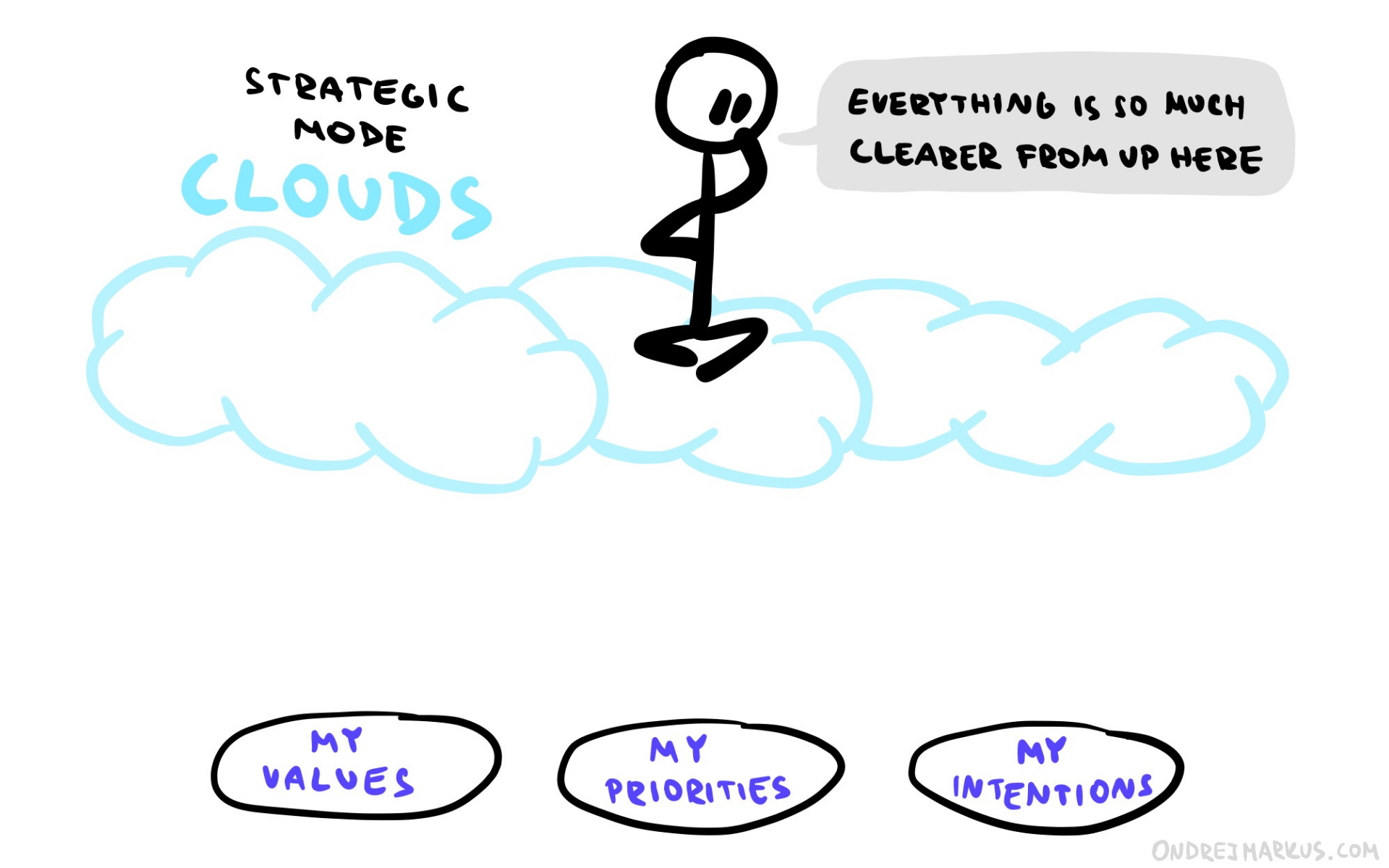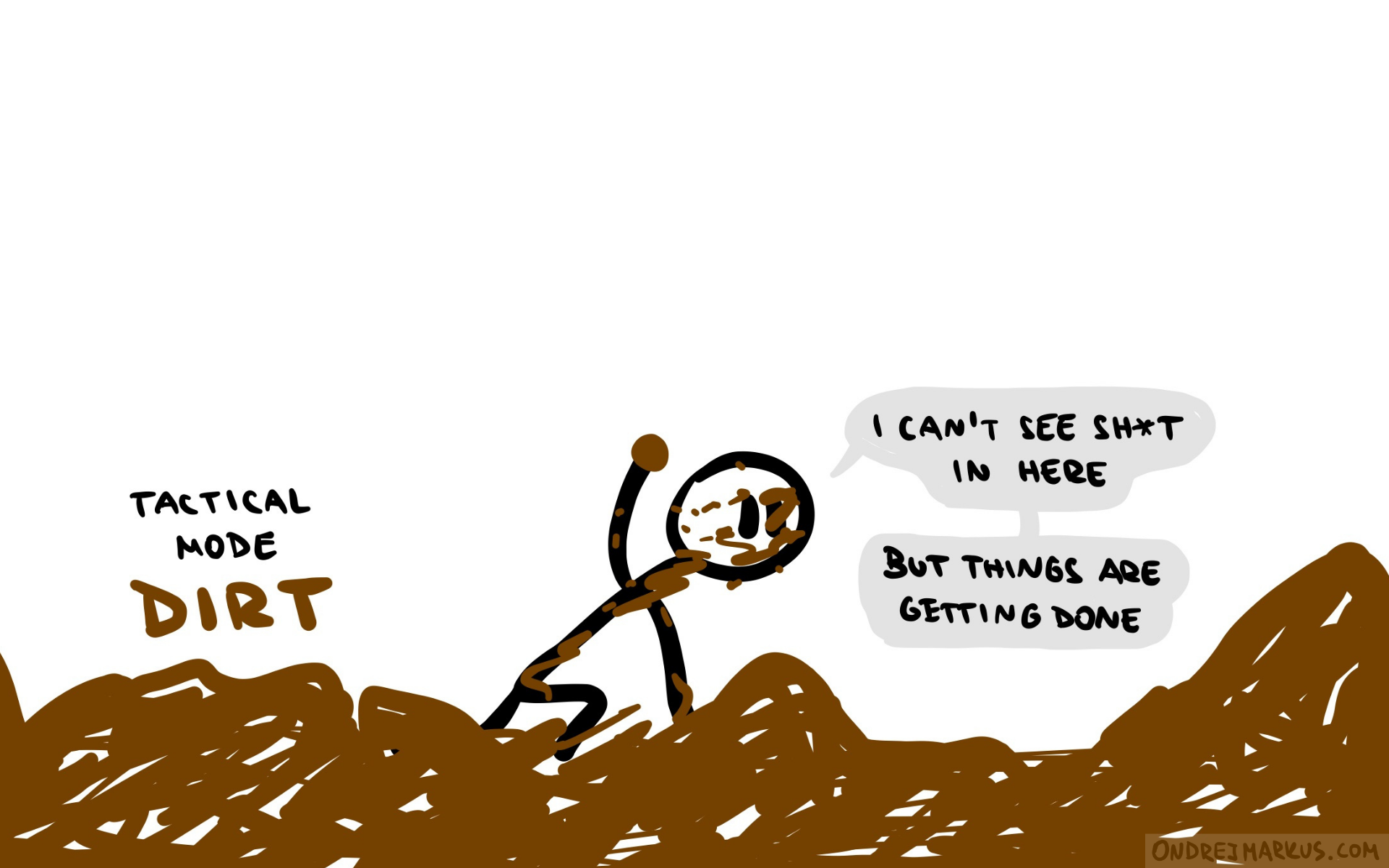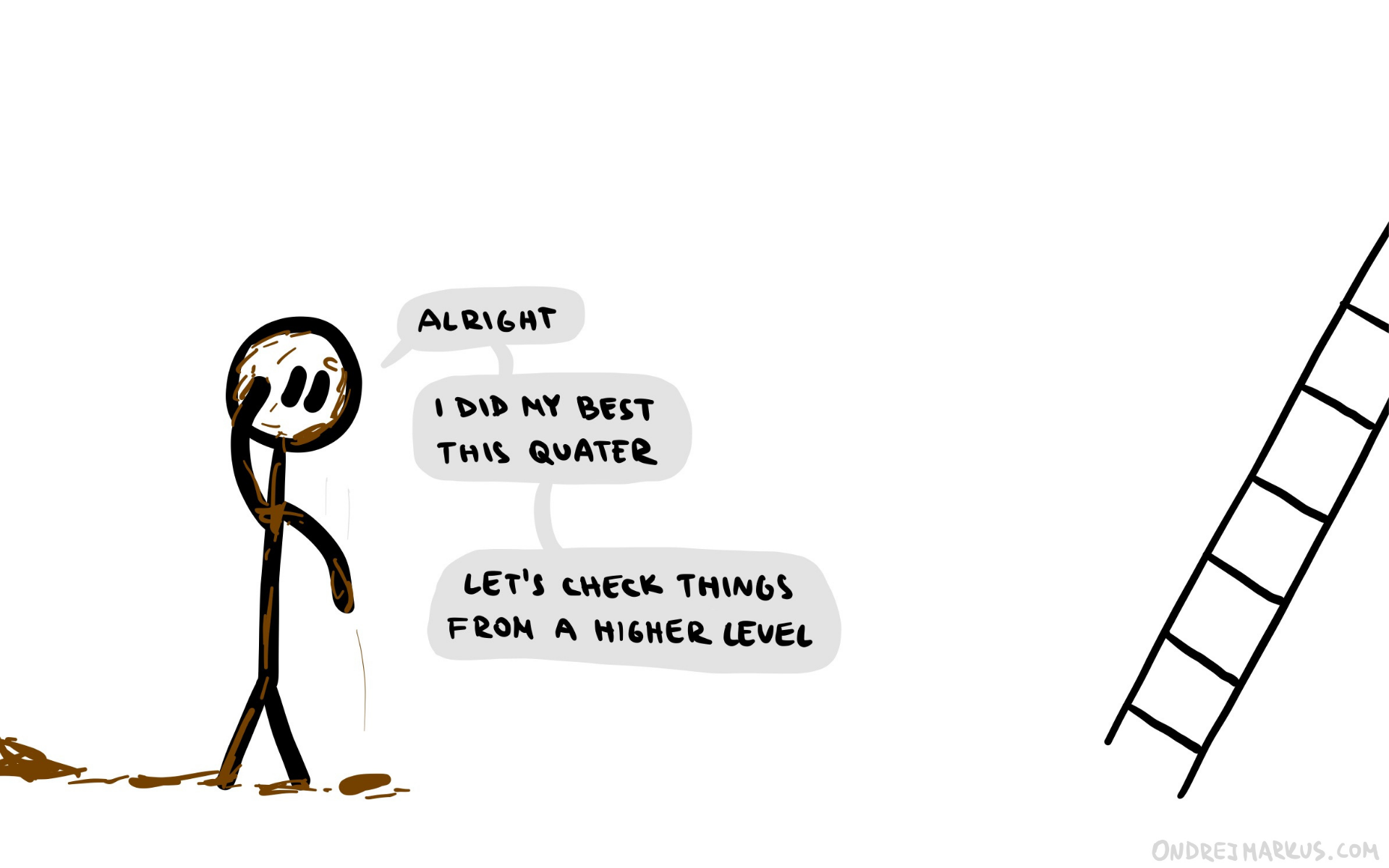Ondrej Markus
Entrepreneur in ed-tech, building the future of education as a founder and CEO at Playful.
I write about the future of education, designing learning games, and running a startup.
I'm a generalist, introvert, gamer, and optimizing to be useful.

Prime your mind for better decisions

When you are about to make a big decision, it deserves your highest state of mind.
- High energy, not exhausted
- Calm, not anxious
- Focused, not distracted
I have been priming my state of mind for the last two weeks because I’m considering a big change in my life.
So, today, I will show you how I prime my state of mind before making life-changing decisions.
Switching modes: Strategic vs. Tactical
Before I show you how I prepare for high-level planning, I need to explain the difference between the two perspectives I switch between in life: Strategic and Tactical.
Strategic mode: In the clouds
This is a high-level planning and reflection mode. It’s about the big picture of life.

Higher perspective
- Where am I going in life?
- What are my values?
- What’s the meaning of my work?
- What impact am I trying to have?
- What do I want to do next in life?
The purpose of the Strategic mode is to help me see things from a higher perspective, figure out what I want, and make intelligent decisions on how to best get it.
Tactical mode: In the dirt
This is a low-level execution mode. It’s about the everyday tasks of life.

Everyday messiness
- What will I focus on today?
- How can I stop procrastinating on my most important project?
- What article should I write next?
- What do I want to finish this week?
- What should my daily routine look like?
The purpose of the tactical mode is to help me finish important work while enjoying the process as much as possible.
I try to switch between these two modes at the right time to leverage their strengths while minimizing their weaknesses.
This is how I do it:
Switch your mode intentionally
Both of these modes have their role, but they do a poor job in each other’s territory. You want to know which one you are in and play by its rules until you decide to switch gears.
Why is that?
If you try to be in the Strategic mode every day, you will get stuck in the big questions of life and get nothing done. You will wonder about the meaning of life instead of finishing the project that’s due tomorrow.
The Tactical mode is useful for everyday life because it helps you focus and get your work done. It’s effective. But it’s also dangerous to stay in there for too long. Because if you never pause to reflect and check if what you’re doing is aligned with your needs and values, you will end up somewhere you hate being.
My approach to balancing this is to work in cycles I call sprints. Every sprint is one cycle of:
Strategy phase (planning) + Tactical phase (execution)
The Strategic phase lasts from one day to up to a week depending on how big of a change am I considering.
And the tactical phase then goes on for the next month or more, until it’s time to pull my head up from the dirt and go back to the strategic drawing board in the clouds, where I can see things more clearly.

Everyday messiness
These two work together in a continuous rhythm. On a bigger timeline, it could look like this:

Strategy-Tactical Rhythm
While I’m in the everyday struggle, things get fast and messy and I embrace it. There is no way around it because unexpected problems will get in the way and I have to deal with them on the spot. That’s 99% of the life experience.
But when I need to switch into the Strategic mode, I want my mind in the clearest, most rested, and focused state possible.
Why?
Because I don’t want to make a life-changing decision like…
- Quitting/starting a new project or job
- Moving to a different continent
- Getting a dog
- Or starting a family
… when my state of mind isn’t as clear as possible.
I want to do as much as I can to ensure I’m on top of my game when making big life-changing decisions.
How to prime your state of mind
Now, we get to the priming part.
I was in Tactical mode for the last three months. I mostly focused on publishing two articles every week without worrying too much about the bigger picture.
It worked. I was on schedule with every article. (Finished 26 articles including this one.)
Today is the last day of that three-month period. So I slowed down over the last two weeks to get ready for a big Strategic phase. And I did my best to get my mind into the best state possible.
This is what I did:
Getting to a high-energy state
Energy defines my mood. When I’m low on energy, I usually feel down and demotivated. When high on energy, I’m optimistic and up to any challenge.
So my mood and motivation come down to my energy management.
- Prioritize sleep: I need 9 hours of sleep every night. Ideally from about 10 pm to 7 am. I can’t always stick to it in the messiness of an average day. But I prioritized sleep over everything else in the last two weeks and averaged 9,78 hours of sleep per night. Sleeping better is the best thing you can do for your state of mind.
- Eat better: I generally try to eat well. I just doubled down on some things like gluten and refined sugars, which I was indulging over the last few months. I cut them out (almost) completely for the last two weeks. Sugar messes up my energy and mood horribly.
- Exercise (a little) more: Nothing crazy. Anything abnormal would just hurt my energy levels. No hard-core gym sessions. So, because it was sunny for the whole two weeks, I went for long 1 or 2-hour walks almost every day. Sometimes alone just to think. Sometimes with a friend. Sometimes taking a call/online meeting on the go.
Getting calm and focused
Next to being high on energy, I also need to feel calm and undistracted by my circumstances.
- Work less: I cut some of my deep work time to put more time into rest and other chill activities. I worked 30-50% less over the last two weeks.
- Cut media consumption: Twitter and other things with feeds in them make me anxious and distracted. So I didn’t use any social media. Also, I stopped watching videos when eating and before bed (which helped with sleeping more and better a lot).
- Reflect more: I spend more time than I normally do on journaling just to think about what are the important questions I might want to answer in my strategy phase.
- Deep talks with friends: Talking things out with people you trust and respect is helpful. So I had more than a few conversations about how others approach some of the questions I’m trying to answer for myself.
- Read philosophy: Solving big questions of life requires some big ideas. So I did some heavier reading which I typically avoid while focusing on getting things done.
My point is…
Your life is your ultimate performance. So why not prepare for the key moments like an athlete would for a competition?
Prime your state of mind to be your best self whenever making important decisions in life.